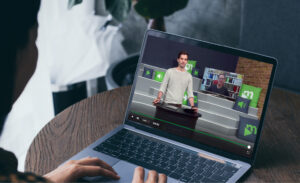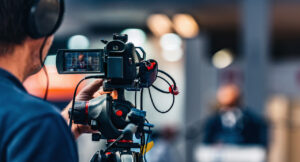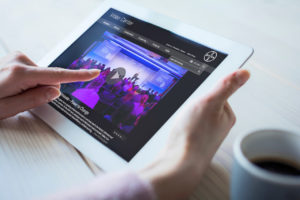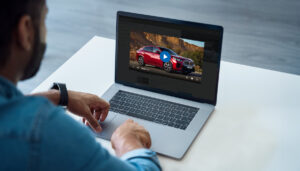What do you need to stream?
Do you want to broadcast content live over the internet? You will need at least a camera, a microphone, streaming software or app and an internet-enabled transmission device. The simplest version is a smartphone with the social media app you trust.
Log in, start broadcasting, look into the camera – off you go.
However, you probably won’t produce a stream worth watching this way.
Experienced streamers use a few extras in addition to the basic equipment to achieve above-average quality in their broadcasts. For example, ring lights or softboxes for better lighting, green screens and also several monitors to reconcile a wide range of streaming tasks.
Camera
If you are just starting out with live streaming, a normal webcam or even the integrated camera in a laptop can be perfectly adequate. In many cases, you can also use the camera on your smartphone to stream in high-resolution Full HD quality without major expense.
This “basic equipment” is enough to stream good webinars, meetings or Let’s Plays, for example.
If you still want to upgrade your streaming camera for little money, it’s worth taking a look at this webcam:
Truly professional streamers rely on high-quality system and digital cameras to enable higher image quality and more control and flexibility over the various settings.
Investing in this more expensive product class is particularly worthwhile if you earn money with your broadcasts or stream in a more professional context, for example to broadcast speeches to a public audience.
Particularly for large and important events, such as product launches, town halls or shareholder meetings, it is worth focusing on image quality in order to make the best possible impression.
This is a good example of a high-quality digital camera:
Microphone
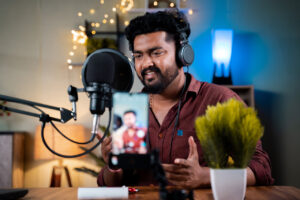
Good audio quality is almost more important than picture quality when streaming, as most content is transmitted verbally. A slightly pixelated image is more forgivable than a noisy audio track.
There is an extensive selection of microphones for live streaming, ranging from simple headset microphones to professional stand microphones.
Probably the cheapest option for a microphone is the headset. This combines headphones and microphone in one. Of course, it depends entirely on your preference whether you want to wear headphones in the stream or not.
A headset is always suitable for smaller events such as workshops or gaming, especially for streaming beginners who are still unsure which equipment works best for them at the start.
This headset offers good value for money:
If you are prepared to spend a little more money, then we recommend a stand microphone or a USB microphone. This comes with a stand so you can attach it at any height and a pop screen to filter out noise.
Well-known streamers such as Papaplatte, Trymacs and Unge use the following microphone:
The advantages of such a microphone over a headset are
- Clearer, finer sounds
- Noise reduction
- More professional sound quality
- Less susceptibility to feedback
However, this does not mean that all USB microphones are automatically better than all headset microphones.
In summary, however, the quality is higher and ideally suited for professional live streams or webinars.
Streaming software / encoders
The heart of your livestreaming equipment is the so-called encoder. An encoder receives the signals from your video and audio sources, processes them and transmits the final product to the streaming server of your choice.
Video encoding offers a number of advantages, including
- Reduces the file sizes of your recordings and enables the smoothest possible stream
- Changes or adjusts video or audio quality
- Makes your stream compatible with end devices
Encoders are divided into hardware and software solutions.
Hardware encoders are small devices with dedicated processors that can process a stream independently of computers. Many hardware encoders also support mobile connections, making them ideal for mobile use in professional streaming setups.
However, for most streaming applications – and especially for beginners – software encoders are perfectly adequate. Software encoders process the audio and video signals directly on your computer or smartphone without having to rely on additional hardware.
Social media apps such as Instagram, Facebook or TikTok have integrated encoding solutions. However, you need separate software for streaming to YouTube, Twitch or other streaming servers.
Open Broadcaster Software, or OBS for short, is ideal for getting started, offers a lot of functions and is also free.
For live streaming in companies, many prefer a more independent solution for processing and hosting the live stream.
Especially when streaming company events, speeches by employees or important meetings of supervisory boards or shareholders, requirements must be met that are not possible with free streaming platforms.
We developed the movingimage LiveStream Pro to meet precisely these requirements. Enhanced security and data protection features (geo/IP restrictions, SSL encryption, login protection) guarantee secure access on the intranet and internet, while the content delivery network also enables smooth transmission to tens of thousands of viewers simultaneously.
LiveStream Pro: Livestreaming for enterprises
Computer
A powerful processor and RAM are essential for smooth streaming. We therefore also recommend that beginners make sure they have at least 8 GB of RAM, or even better 16 GB, to speed up the processing speed of various processes.
The processor should have several cores, as it carries the main load when streaming. Six cores are the minimum.
Internet speed
A stable internet connection is one of the basic requirements for a good live stream. After all, a smooth transmission is only possible if the image and sound can be sent to the streaming server without interruption.
The value that matters here is the upload rate. This indicates how much data can be transmitted to the server per second.
For a smooth transmission with a picture quality of 1080p, at least 4.5 – 6 MBit/s should be available for the upload. For a transmission with 720p, at least 3.5 – 5 Mbit/s are required.
Lighting

Let there be light! – The right contrast, color saturation and brightness are also essential when you present yourself in front of the camera. None of your viewers want to see you sinking into the shadows.
With a suitably selected light, you can really set the scene and enable more detailed shots with your camera.
Of course, there are also different price ranges for light. If you have never worked with exposure before, a simple ring light could be a good start for you.
Ring lights are very inexpensive compared to the rest of the equipment, with good entry-level models available for around €20.
A notable disadvantage of ring lights in this price range is that you have to sit close to the light, making them more suitable for close-up shots.
A so-called softbox is somewhat more expensive, but also more versatile in use. These range from around €40-100. The main benefit here is the large-area illumination. Unlike a ring light, the color tone and brightness remain the same.
Green screen
A green screen is a worthwhile purchase if you want your livestreams to be about more than just you. The background of your stream can be easily replaced digitally with other content using a green screen. This could be a static image to simulate a studio, for example, but also video content, animations, presentations or the screen recording of a video game.
Sometimes a green screen is also worthwhile to hide the actual background – for example because it is too boring or untidy.
You can get a decent green screen background for as little as €30.
Better green screens cost between €100 and €150, offer higher quality, their own tripod and can sometimes be rolled up to save space.
Conclusion
It really doesn’t take much to produce a good livestream. Especially at the beginning, it is enough to use the equipment that you may already have at your disposal. Internal meetings, employee speeches and town hall meetings don’t necessarily need the most expensive equipment, green screens, large-scale lighting or a 4K digital camera.
If you’re willing to experiment a little, analyze your livestreams afterwards and listen to your viewers’ feedback, you’ll quickly see where it’s worth investing in more professional streaming equipment.
Find out more about livestreaming and how you can use it to your advantage in our webinar!


